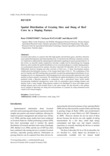Spatial Distribution of Grazing Sites and Dung of Beef Cows in a Sloping Pasture
| ISSN | 00213551 |
|---|---|
| NII recode ID (NCID) | AA0068709X |

Livestock select places in a pasture that offer high-quality and nutritious grass, and these selections cause spatial heterogeneity and reduced productivity. To maximize the efficiency of pasture systems, it is important to understand the spatiotemporal information regarding livestock grazing behavior. In this review, we describe studies conducted to develop a simple tool for determining cow foraging behavior, and to predict the spatial distribution of cow excrement (dung) in a steeply sloping pasture. An accelerometry-based activity monitor, the Kenz Lifecorder EX (hereafter, the LC), was used to differentiate between foraging and other activities of beef cows. A linear discriminant analysis yielded good discrimination accuracy of the minute-based data of the LC. The combination of the activity timeline and GPS tracking data successfully revealed the spatiotemporal distribution of cow foraging activity in a sloping pasture. Both foraging activity and excretion play important roles in the nutrient cycling in pasture ecosystems. We found that the spatial distribution of cow dung could be predicted using a Bayesian approach in conjunction with a generalized linear mixed model incorporating conditional autoregressive terms with two parameters (green herbage biomass and distance from a water trough). Dung deposits tended to be distributed in areas with higher green
herbage biomass and in areas located closer to the water trough. We also describe a new pasture survey method of detecting cow dung and weed positions in a pasture by using unmanned aerial vehicle (UAV)-based imagery.
| Date of issued | |
|---|---|
| Creator | Rena YOSHITOSHI Nariyasu WATANABE Jihyun LIM |
| Subject |
accelerometer cattle dung UAV |
| Publisher | Japan International Research Center for Agricultural Sciences |
| Received Date | 2019-10-16 |
| Accepted Date | 2020-01-24 |
| Available Online | |
| Volume | 54 |
| Issue | 4 |
| spage | 299 |
| epage | 306 |
| DOI | 10.6090/jarq.54.299 |
| Language | eng |
